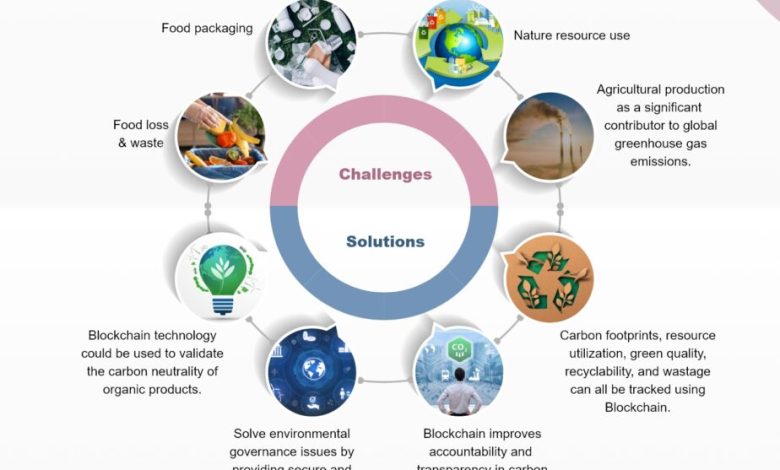The Role of Blockchain in Environmental Sustainability

- Understanding the Basics of Blockchain Technology
- Exploring the Potential Impact of Blockchain on Environmental Sustainability
- Case Studies: How Blockchain is Being Used to Address Environmental Challenges
- Challenges and Opportunities in Implementing Blockchain for Environmental Sustainability
- The Role of Smart Contracts in Promoting Green Practices
- Collaborative Efforts: How Various Industries are Leveraging Blockchain for a Greener Future
Understanding the Basics of Blockchain Technology
Blockchain technology is a decentralized, distributed ledger system that securely records transactions across a network of computers. It operates on the principles of transparency, immutability, and security, making it an ideal solution for various industries, including environmental sustainability.
One of the key features of blockchain is its ability to create a tamper-proof record of transactions, which can help in tracking and verifying the authenticity of environmental data. This can be particularly useful in monitoring carbon emissions, tracking supply chains, and ensuring compliance with environmental regulations.
By using blockchain technology, organizations can increase transparency in their operations, reduce the risk of fraud, and improve the efficiency of their processes. This can lead to better accountability and trust among stakeholders, ultimately contributing to a more sustainable environment.
Overall, understanding the basics of blockchain technology is essential for realizing its potential in promoting environmental sustainability. By leveraging its unique capabilities, organizations can make significant strides towards a greener future.
Exploring the Potential Impact of Blockchain on Environmental Sustainability
Blockchain technology has the potential to revolutionize the way we approach environmental sustainability. By providing a secure and transparent platform for tracking transactions and data, blockchain can help monitor and verify the authenticity of environmental initiatives. This can lead to increased accountability and trust in sustainability efforts, ultimately driving more impactful results.
One of the key benefits of blockchain in environmental sustainability is its ability to create immutable records of transactions. This means that once data is entered into the blockchain, it cannot be altered or tampered with. This feature can help prevent greenwashing and ensure that companies are held accountable for their environmental claims.
Furthermore, blockchain can streamline processes such as carbon trading and renewable energy certificate tracking. By automating these processes and reducing the need for intermediaries, blockchain can help lower costs and increase efficiency in the sustainability sector.
Overall, the potential impact of blockchain on environmental sustainability is vast. By leveraging this technology, we can create a more transparent, efficient, and trustworthy system for driving positive environmental change.
Case Studies: How Blockchain is Being Used to Address Environmental Challenges
Several case studies demonstrate how blockchain technology is being utilized to tackle environmental challenges effectively:
- Carbon offsetting: Blockchain is being used to create transparent and secure platforms for tracking carbon offset credits. This helps in verifying the legitimacy of carbon offset projects and ensures that the credits are not double-counted.
- Supply chain transparency: Blockchain enables companies to trace the origin of products and raw materials, ensuring that they are sourced sustainably. This transparency helps in reducing illegal logging, wildlife trafficking, and other environmentally harmful practices.
- Renewable energy trading: Blockchain facilitates peer-to-peer energy trading, allowing individuals and businesses to buy and sell excess renewable energy directly. This decentralized approach promotes the use of clean energy and reduces reliance on fossil fuels.
- Waste management: Blockchain is used to track the disposal and recycling of waste materials, ensuring that they are managed efficiently. This helps in reducing landfill waste and promoting a circular economy.
- Biodiversity conservation: Blockchain is employed to create digital records of land ownership and conservation efforts, protecting biodiversity hotspots from illegal deforestation and development. This technology helps in preserving ecosystems and endangered species.
Challenges and Opportunities in Implementing Blockchain for Environmental Sustainability
Implementing blockchain technology for environmental sustainability presents both challenges and opportunities. One of the main challenges is the complexity of integrating blockchain into existing systems and processes. This requires significant investment in terms of time, resources, and expertise. Additionally, there are concerns about the scalability and energy consumption of blockchain networks, which can have negative implications for the environment.
On the other hand, blockchain offers numerous opportunities for enhancing environmental sustainability. By providing a transparent and immutable ledger, blockchain can help track and verify the provenance of products, ensuring that they are sourced and produced in an environmentally friendly manner. This can help consumers make more informed choices and incentivize companies to adopt sustainable practices.
Furthermore, blockchain can facilitate the trading of carbon credits and other environmental assets, making it easier for organizations to offset their carbon footprint. Smart contracts can automate the verification and enforcement of environmental agreements, reducing the need for intermediaries and streamlining processes. This can lead to greater efficiency and cost savings in environmental initiatives.
Overall, while there are challenges to overcome, the potential benefits of implementing blockchain for environmental sustainability are significant. By leveraging this technology effectively, we can create a more transparent, efficient, and sustainable future for our planet.
The Role of Smart Contracts in Promoting Green Practices
Smart contracts play a crucial role in promoting environmentally friendly practices by automating and enforcing sustainable agreements. These contracts are self-executing agreements with the terms of the contract directly written into code. By utilizing blockchain technology, smart contracts can ensure transparency, traceability, and accountability in green initiatives.
One of the key benefits of smart contracts is their ability to reduce the need for intermediaries, thereby cutting down on costs and potential errors. This efficiency not only streamlines processes but also minimizes the environmental impact of traditional paper-based contracts. Additionally, smart contracts can facilitate the tracking of carbon emissions, waste management, and other sustainability metrics.
By incorporating smart contracts into supply chains, companies can verify the authenticity of eco-friendly products and ensure compliance with environmental regulations. This level of trust and verification is essential in promoting green practices and fostering consumer confidence in sustainable products. Furthermore, smart contracts can incentivize eco-friendly behavior through rewards and penalties, encouraging stakeholders to adopt more environmentally conscious practices.
Collaborative Efforts: How Various Industries are Leveraging Blockchain for a Greener Future
Various industries are coming together to explore the potential of blockchain technology in promoting environmental sustainability. By leveraging blockchain, these industries are able to collaborate on initiatives that aim to reduce carbon emissions, promote renewable energy sources, and improve resource management.
One way in which industries are utilizing blockchain for a greener future is through the creation of transparent supply chains. By using blockchain to track the origin and journey of products, companies can ensure that they are sourced sustainably and ethically. This transparency not only helps to reduce the environmental impact of production but also builds consumer trust in the products they purchase.
Another collaborative effort that is gaining traction is the use of blockchain in carbon offsetting projects. By tokenizing carbon credits on a blockchain network, companies can easily trade and track their carbon footprint. This not only incentivizes companies to reduce their emissions but also creates a more efficient market for carbon offsetting.
Furthermore, the energy sector is exploring how blockchain can facilitate the transition to renewable energy sources. By creating decentralized energy grids powered by blockchain technology, communities can generate, store, and trade renewable energy more efficiently. This not only reduces reliance on fossil fuels but also promotes a more sustainable energy ecosystem.



